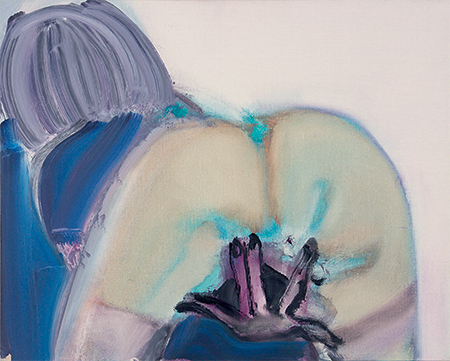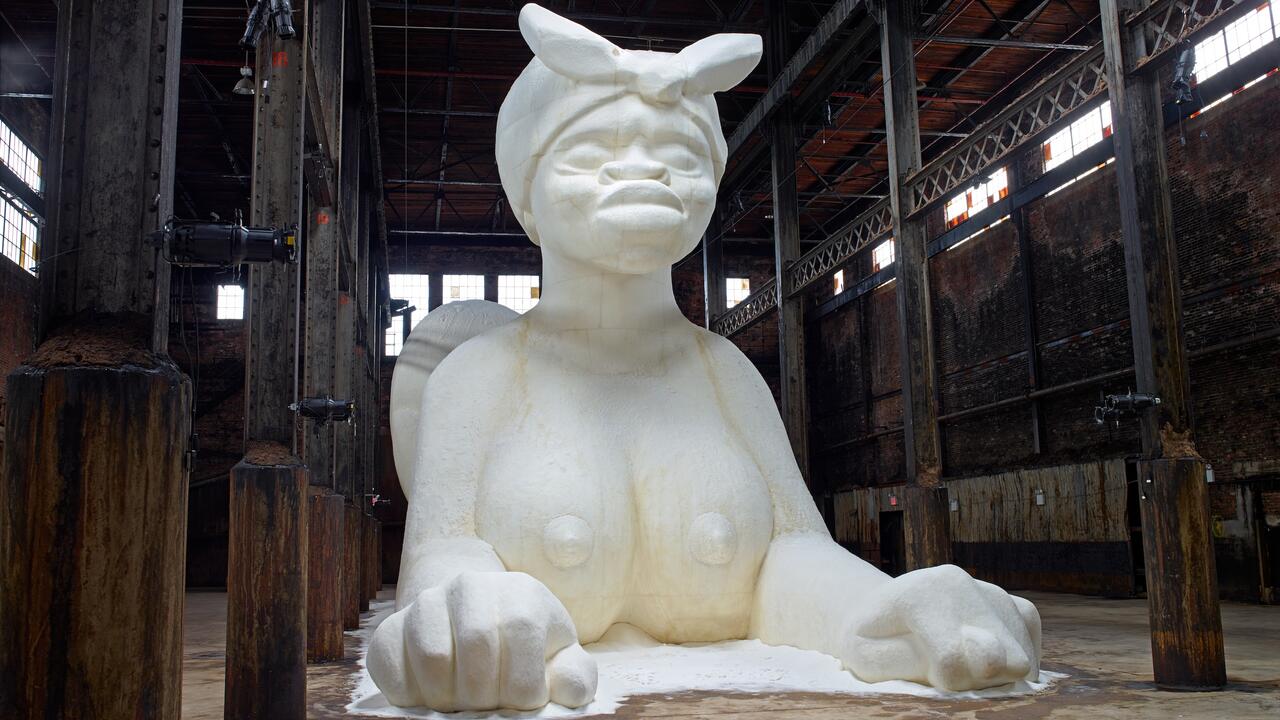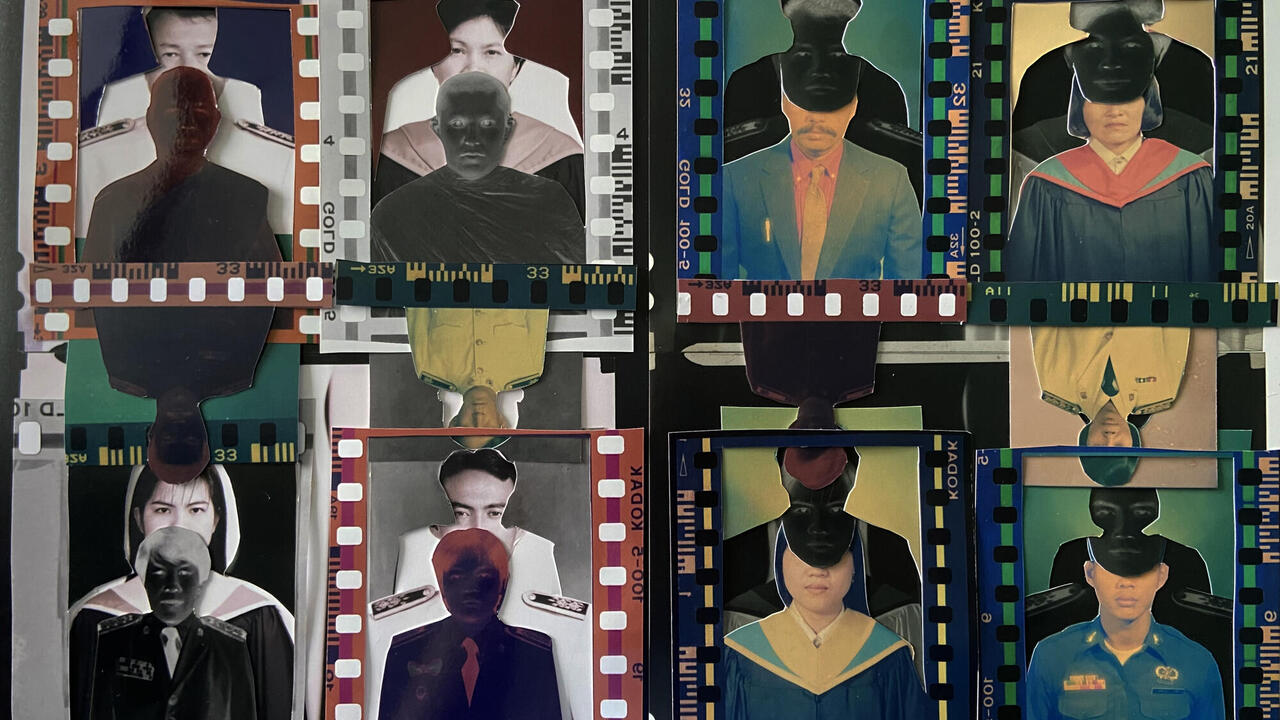A Wall to Object to
Caoimhín Mac Giolla Léith examines the relationship between image and painting in the work of Marlene Dumas
Caoimhín Mac Giolla Léith examines the relationship between image and painting in the work of Marlene Dumas

‘An image needs an edge to relate to, and a painting needs a wall to object to.’ 1
Marlene Dumas
Let us take a pair of portraits – one well known, one not – and see what they suggest about the work of Marlene Dumas. The first is an emblematic oil painting on canvas derived from a photograph, as ever with Dumas (aside from a few early works). The Painter (1994) depicts a naked child, standing alone, glowering defiantly, her paint-smeared hands hanging by her sides. This work graces the cover of the catalogue for Dumas’s first European retrospective, ‘Marlene Dumas: The Image as Burden’, which opened in September at the Stedelijk Museum in Amsterdam, the artist’s home since she arrived there from South Africa as a young woman in the mid-1970s.
The second image is a casual photograph reproduced as supplementary material in the exhibition’s catalogue. Taken some years after the snapshot on which The Painter is based, it features the same little girl: Dumas’s daughter Helena, aged nine. Dressed in white, she stands demurely in a corner of one of the Stedelijk’s galleries, amid a group show of art from the Netherlands, dwarfed and hemmed in on both sides by huge paintings by her parents: Dumas and her Dutch partner Jan Andriesse. Her mother’s two works, looming darkly to her right, are three-metre-tall portraits from the mid-1990s ‘Magdalena’ series, many of which are personifications of the archetypical ‘fallen woman’ redeemed. In the painting hanging nearest the little girl, Magdalena (Manet’s Queen/Queen of Spades) (1995) – based on a magazine image of the model Naomi Campbell – the naked woman’s ankles and feet are pale, as if blackness were a body-stocking that might be pulled on and off at will. A century and a half after the controversial reception of Édouard Manet’s Olympia (1863), to which the work’s subtitle alludes, it is hard to imagine a painting inciting a comparable mixture of moral outrage and aesthetic affront. That said, Dumas’s picture is simultaneously alluring and disconcerting in its own (im)modest way. Given that the artist’s rendering of the dark-skinned figure is barely distinguishable from the shadowy background, the viewer’s natural inclination is to approach the painting to discern its detail. The giant Magdalena’s crotch sits at eye level, and this close encounter is a bit like bumping into a naked Neytiri, from the 2009 film Avatar, down a dark alley. Meanwhile, to young Helena’s left is a shimmering expanse of rainbow-like gradated colour in her father’s signature mode of late-Modernist abstraction.

The Freudian ‘family romance’ staged in this obscure photo, when viewed in tandem with the iconic painting with which we began, offers the daughter as a character by turns empowered and overwhelmed by a heritage of picture-making, both figurative and abstract, which may be received as a blessing or a curse. The title of this retrospective, ‘The Image as Burden’ – borrowed from a small painting by Dumas from 1993 of a naked man carrying the inert figure of a woman in a flowing white robe (is she dead or has she fainted?) – favours the second option. The source image for this inverted pietà, it seems, is a film still of Greta Garbo cradled in Robert Taylor’s arms in Camille (1936), the classic weepie of golden-age Hollywood.
For decades, Dumas has supplied a running commentary on the gap between her work’s intention and its reception via a stream of aphoristic ‘poems’, often marked by a mischievous literalism. In a similar vein, The Image as Burden’s underhanded salute to a movie icon who withdrew from public view at the height of her fame is an intimation of how traditional ‘to-be-looked-at-ness’ (i.e. woman as image) can be literally difficult to bear. The two most striking elements in the painting are the ghoulish mask of impasto that is the woman’s face and the crudely rendered man’s hand as he awkwardly supports his charge, while gazing at her with concerned affection. His rude mitt is a stark patch of black paint against the immaculate white of the woman’s robe, which, as the critic Wendy Steiner once noted, effectively ‘creates a dark pubis for her, as her own sex is hidden’: ‘Unlike Titian’s Venus of Urbino or Manet’s Olympia, in which the woman’s hand hides and at the same time presents her pubis in a visual simulation, here it is the man whose supporting hand must perform this scandalous ostentation, for she is no longer able to do so on her own.’2

This inability (and, indeed, inexplicitness) is the exception rather than the rule, as any number of paintings worked up from Dumas’s stockpile of print pornography and Polaroids of working strippers can attest. A telling visual rhyme with a later painting of precisely the same dimensions as The Image as Burden, titled Fingers (1999) – depicting a semi-clothed woman on her knees, facing away from us, one hand stretched around under her naked behind to splay her sex and provide a better view – may also serve as a reminder that modern porn’s repertoire of poses is no less codified than that of the Old Masters. Dumas has insisted that, as a maker of paintings – as opposed to a taker of photographs, which of course she also is – ‘[the] aim is to “reveal” not to “display”. It is the discourse of the lover. I am intimately involved with my subject matter […] I am not disengaged with the subject of my gaze.’3 From the viewer’s perspective, however, this may seem truer of some of her paintings than of others, in spite of the transformation of photographic source materials involved in their production. Dumas’s own defence of Fingers, as well as related works drawn from ‘pornobooks’, contrives to retrieve the requisite sense of intimacy through a combination of displacement and projection: ‘Because I can’t see myself when I do the things I do, / I don’t know how I look when I look at you.’4
The variety of found imagery, augmented by her own photographs, on which Dumas bases her paintings is well documented and longstanding, though there have been shifts in emphasis over the years. From my one brief trip to the artist’s Amsterdam studio back in 1996, I remember a floor strewn with photocopied press images of models and celebrities, including Campbell and Princess Diana, the twin subjects of one of her oddest and most arresting works of oblique social commentary, the diptych Great Britain (1995–97). I also recall a pub conversation I had with Dumas, during which she delightedly reported that her (female) assistant had turned up with some porn mags containing ‘images that even I cannot use’. In fact, Dumas has always been disarmingly generous in divulging her sources, ever since the early Love vs Death (1980). In this monumentally chaotic work of collage and blueprint drawing, she first set out her stall in an explosion of images and text that includes the aforementioned film still from Camille, as well as a photograph of the aged, bedridden Peggy Guggenheim, bluntly glossed: ‘Is she dead yet?’ In response to a query by the critic Richard Shiff, as he prepared a catalogue essay for her 2008 us retrospective, Dumas revealed that her well-known painting The Kiss (2003) was derived from the closing image of the famous shower scene in Hitchcock’s Psycho (1960), adding simply that nobody had asked her about the source before.5
Which begs the question: how much does the viewer gain when armed with such insider knowledge? No amount of dutiful detective work can account for the confounding visceral impact of Dumas’s most consummate paintings and works on paper when encountered in person. The veteran South African photographer David Goldblatt has spoken of his awestruck conversion to her work on finally seeing an exhibition of her paintings, after having spent some time puzzling over catalogue reproductions, unsure what the fuss was about. The boldly skittering drawn line that supplies Dumas’s painted images’ essential undergirding; the translucent washes, creamy swipes and clotted gobs of oil paint; the swiftly arcing, swerving and stabbing brushstrokes; the occasionally startling use of colour (an underappreciated aspect of Dumas’s painting, obscured to some extent by the work’s frequent thematization of blackness and whiteness); the virtuoso sloshing and puddling of watercolour on dexterously tipped and tilted sheets of paper, sometimes given extra sparkle by the admixture of metallic acrylic. To many viewers, these are the qualities that constitute the essence of Dumas the painter.

And yet, in spite of her commitment to the medium, any attempt to situate her work primarily in relation to the shifting fortunes of painting (or indeed drawing) will always fall short. True, René Daniels was an early, local touchstone, and comparisons with Luc Tuymans were always inevitable, though a two-person show last year at Zeno X Gallery in Antwerp showcased intriguing divergences in form and content between the two artists, both on the gallery walls and in a recorded conversation. Shared concerns with other European contemporaries who work across several media, from Thomas Schütte to Rosemarie Trockel, seem equally pertinent. The tension between individual and type explored in Dumas’s panoramic portrait grids, from Models (1994) to Man Kind (2005–06), owes much to a photographic lineage that runs from August Sander through Bernd and Hilla Becher to their celebrated students, and to Dumas’s slightly younger Dutch contemporary Rineke Dijkstra. Casting the net across the Atlantic, a consideration of such Pictures Generation peers as Sarah Charlesworth, Barbara Kruger, Sherrie Levine and Cindy Sherman is surely crucial in assessing an artist who has always been alert to distinctions between taking and making pictures.
All of which suggests that, from the outset, lying at the root of Dumas’s art is an exploration of the difference between an image and a painting. ‘When looking at images,’ she once claimed, ‘I’m not lost, / but I’m uneasy.’6 This disjuncture has been exacerbated by subsequent developments in the technological dissemination of imagery. That she should sometimes couch her thoughts on this matter in explicitly political terms is unsurprising, given her work’s persistent engagement with questions of race, gender, violence, colonialism and ongoing conflicts in the Middle East. Somewhat more unexpected is her invocation of Ad Reinhardt as a father-figure – an irascible opponent of social injustice who was far better known as a proponent of endgame abstraction: ‘Reinhardt felt that artists who try to make pictures that are also paintings usually fail to do either well. They do it “to avoid political responsibility and aesthetic criticism”. Even though I try to solve this dilemma by trying to make works that look like pictures and act like paintings, I don’t know if he would agree and his approval means a lot to me.’7 This brief apologia is from a commentary on the painting Reinhardt’s Daughter (1994), which Dumas derived from a photograph of Helena sleeping, her skin painted a dark brown. A pendant work, Cupid (1994), based on the same photo, in which the girl’s skin is white, confirms this as another play on essential versus incidental blackness – pigment as racial determinant as opposed to painting material.

If ever there were an artist with a natural inclination to attempt to do several things at once, it is Dumas. And it would be easy to dismiss this heartfelt ambition as misguided. She has certainly endured more than her fair share of critical sniping, especially in the us – one complaint being that her painting is insufficiently transformative of its source materials. Yet the very fact that she sometimes seems to add little to the found image compositionally – other than hemming it into its rectangular frame and turning it into a painting – is in itself striking. Her persistent emphasis on the picture plane’s constraints is remarkable, as isolated bodies contort themselves in order to fit into its confines, or extend their limbs to push against its imaginary walls and ceiling. It is as if human bodies were just so much pictorial material – compliant forms ready to be stretched, folded or crammed into their rectangular cage. The title of Dumas’s us retrospective came from the painting Measuring Your Own Grave (2003), in which the outstretched hands of a bent-over figure claw at the edges of the canvas. No room was found in this European retrospective for Dumas’s body of elongated horizontal paintings (the frame as coffin?), dating back to Snow White and the Broken Arm (1988), many of them modelled on Hans Holbein’s The Body of the Dead Christ in the Tomb (1520–22). The point is that every one of Dumas’s manifestly self-conscious paintings began life as an image of an entirely different order, and they should not be assessed without accounting for the dialogic nature of this double articulation.
Dumas came into her own as an artist at around the same time Thomas Lawson devised the astute analysis and perverse prognosis of his epochal essay ‘Last Exit: Painting’. Announcing, in 1981, the exhaustion of late Modernism and (certain brands of) critical Postmodernism alike, Lawson advocated as the best way forward for the radical artist ‘the appropriation of painting as a subversive method [that] allows one to place critical aesthetic activity at the centre of the marketplace where it can do most damage’, adding that the ‘discursive nature of painting is persuasively useful, due to its characteristic of being a never-ending web of representations’.8 It is unlikely that Dumas’s work was quite what Lawson had in mind back then, though it does fit the bill. Somehow, her paintings seems equally unlikely, more than 30 years later, to figure prominently in ongoing debates about the nature of the image and its various relations: to its mechanisms of production and circulation, to its disparate material ‘carriers’, to its potential sub-categorizations (e.g. starke Bilder or ‘strong images’), to the general domain of art and its systems of evaluation. But if Dumas’s work doesn’t occupy a central place in this discourse, it will have been a missed opportunity.
1 Cornelia Butler, Marlene Dumas: Measuring Your Own Grave, Museum of Contemporary Art, Los Angeles, 2008, p. 95
2 Wendy Steiner, ‘The Burden of the Image’, Venus in Exile: The Rejection of Beauty in Twentieth-Century Art, University of Chicago Press, Chicago, 2001, pp. 32–34
3 Marlene Dumas: Miss Interpreted, Stedelijk van Abbemuseum, Eindhoven, 1992, p. 43
4 Leontine Coelewij, Helen Sainsbury and Theodora Vischer, Marlene Dumas: The Image as Burden, Tate Publishing, London, 2014, p. 41
5 ibid., p. 122
6 ibid., p. 72
7 http://www.brooklynrail.org/special/ad_reinhardt/artists-on-ad/why-i-called-a-painting-of-mine-reinhardts-daughter, last accessed 13 September 2014 8 Thomas Lawson, ‘Last Exit: Painting’, Artforum 20, no. 2 (October 1981), pp. 40–47
Marlene Dumas is a South African artist who lives in Amsterdam, the Netherlands. Her retrospective, 'Marlene Dumas: The Image as Burden', is on view until 4 January 2015 at the Stedelijk Museum in Amsterdam. From there, it will travel to the Tate Modern, London, UK, from 5 February to 10 May 2015, and then to Fondation Beyeler, Riehen / Basel, Switzerland, later next year.





















